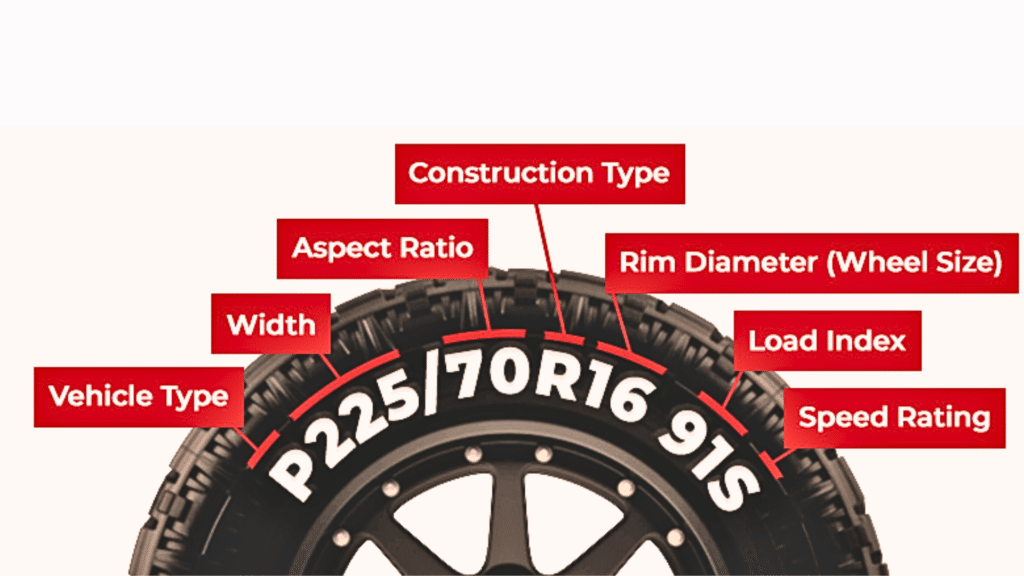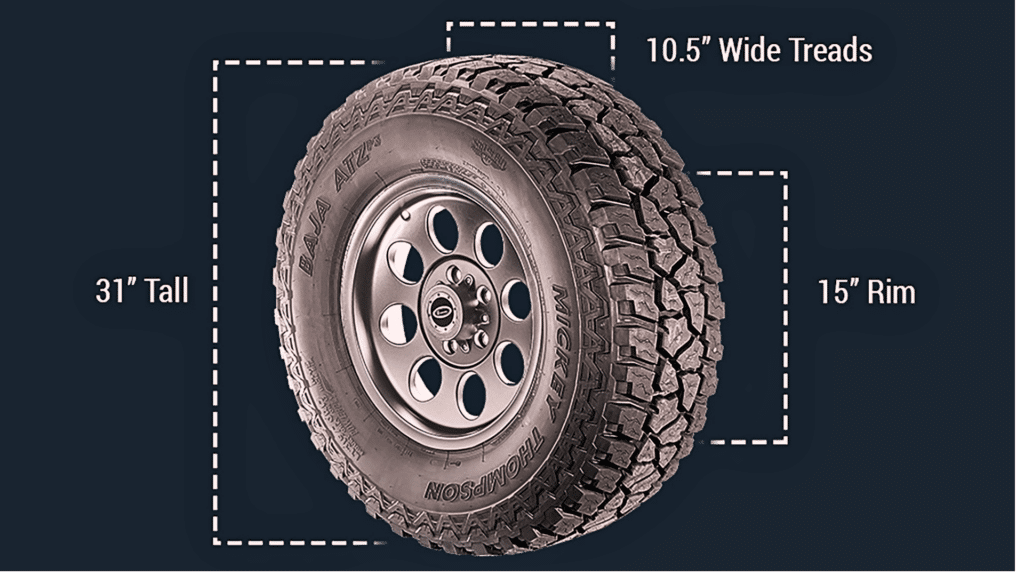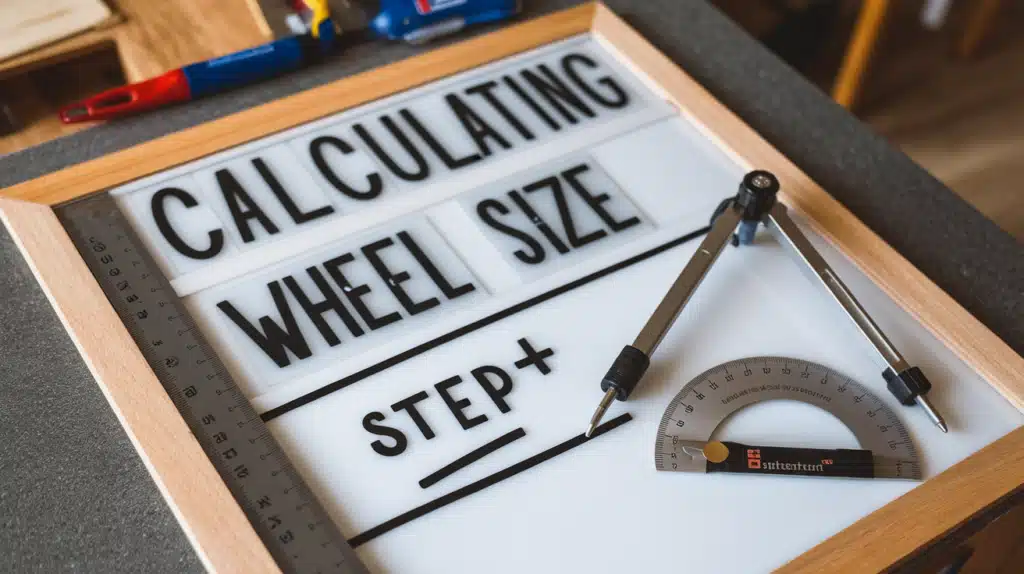Getting your wheel size right matters more than you might think.
Wrong measurements can lead to poor performance, uneven wear, and safety issues.
Buying the wrong replacements can also cost you money.
Many car owners need to measure their wheels – maybe you’re looking to upgrade your tires, replace a damaged wheel, or just want better handling on the road.
Whatever your reason, you need precise measurements to make the right choice.
In this guide, you’ll learn the exact steps to measure your wheel size correctly.
We’ll break down each measurement you need and show you how to get it right the first time.
No complex math or special tools are required – just simple, clear steps anyone can follow.
We’ve helped thousands of car owners get their measurements right, and we’ll help you, too.
Understanding Wheel Size Basics

Let me explain the main wheel measurements you need to know.
Think of your wheel as a puzzle—each measurement fits together to give you the perfect fit.
The Key Measurements:
Diameter is how big your wheel is from one side to the other.
If you get this wrong, your wheel will not fit your car at all. Imagine measuring across the face of a clock—that’s your wheel diameter.
Width tells you how thick your wheel is from the inner edge to the outer edge. This thickness affects how your tires sit and how the car handles on the road.
Offset is the space between the center of a wheel and where it mounts to the car. It prevents the wheel from rubbing against other parts.
Backspacing shows how far your wheel sits inside your car’s wheel well. Too little or too much can cause rubbing issues.
The bolt pattern is the layout of the holes where your wheel attaches to your car.
It needs to match exactly for safety.
Tools You’ll Need
- Measuring tape
- String (for larger measurements)
- Ruler
- Pen and paper
- Flashlight
When these measurements work together, you get better handling, even tire wear, and most importantly – a safe ride.
And don’t worry – I’ll show you how to measure each one properly in the next sections.
Remember: A small mistake in any of these measurements can cause big problems later.
But with the right tools and attention, you’ll get it right.
Step-by-Step Calculation Guide

1. Measuring the Wheel Diameter Correctly
Let me show you the simplest way to find your wheel’s diameter. Most people get this measurement wrong, but I’ll make it easy for you.
Basic Measurement Steps:
- Clean your wheel’s edge
- Place your measuring tape at one end
- Pull it straight across to the other end
- Write down the number in inches
Important: The size marked on your tire might not match what you measure.
Here’s why: A 17-inch wheel often measures closer to 16.5 inches. Manufacturers round up the numbers for easy reference.
Common Mistakes to Avoid:
- Don’t measure at an angle
- Don’t include the tire in your measurement
- Don’t guess based on old measurements
If you’re having trouble reaching across the wheel, use a straight piece of wood or metal as a guide.
Rest your measuring tape on it for a straight line.
I recommend measuring twice to be extra sure. Small errors here can lead to buying the wrong size wheel.
2. Determining the Wheel Width
Here’s how to measure your wheel’s width properly.
This measurement is key to how your tires fit and how your car handles on the road.
Step-by-Step Width Measurement:
- Place your measuring tape on the inner edge of the wheel
- Stretch it straight across to the opposite inner edge
- Note the measurement in inches
- Round to the nearest half-inch
Why Width Matters: The right width helps your tires grip the road better.
Too narrow, and your car might feel wobbly. Too wide, and your tires could rub against your car’s body.
Tips for Accurate Measurement:
- Remove any dirt or rust from the edges
- Keep the tape level while measuring
- Measure at several points to check for damage
- Write down your numbers right away
Watch Out For:
- Bent wheel edges that throw off measurements
- Uneven spots from damage
- The build-up that makes the width seem larger
3. Finding the Offset and Backspacing
Let me explain these tricky measurements in simple terms.
They might seem difficult at first, but I’ll make them clear.
Understanding Offset: Offset is how far your wheel’s mounting surface sits from its centerline.
Think of it like this:
- Positive offset: The mounting surface sits toward the outside
- Zero offsets: mounting surface lines up with the center
- Negative offset: The mounting surface sits toward the inside
How to Measure Backspacing:
- Lay your wheel flat on the ground
- Place a straight edge across the back
- Measure from the mounting surface to the edge
- Write down the measurement in inches
Why These Numbers Matter: The wrong offset can cause your wheels to stick out too far or tuck in too much.
This affects how your car drives and looks.
Bad offset can also cause:
- Rubbing against brake parts
- Weird steering feel
- Stress on your car’s bearings
Quick Tips for Measuring:
- Clean the mounting surface first
- Use a metal ruler for better accuracy
- Double-check your numbers
- Take photos for reference
4. Understanding Bolt Patterns and Lug Spacing
Bolt patterns might look simple, but getting them wrong means your wheel won’t fit at all.
Let me show you how to get it right.
What’s a Bolt Pattern?
It’s the layout of holes where your wheel connects to your car. The pattern includes two numbers:
- Number of lugs (holes)
- Distance between them
How to Measure Your Bolt Pattern:
For 4-Lug Wheels:
- Measure from the center of one lug to the center of the opposite lug
- Write down the measurement in millimeters
For 5-Lug Wheels:
- Measure from the center of one lug to the outside of the farthest lug
- The pattern often looks like a star
Common Patterns You’ll See:
- 4×100: Four lugs, 100mm spacing (Honda Civic)
- 5×114.3: Five lugs, 114.3mm spacing (Toyota Camry)
- 6×139.7: Six lugs, 139.7mm spacing (Ford F-150)
Tips for Getting It Right:
- Use a proper bolt pattern gauge if you can
- Clean the lug holes before measuring
- Check both sides of the wheel
- Count the lugs twice to be sure
Additional Factors to Consider When Calculating Wheel Size
1. Beyond Basic Measurements
Even with perfect measurements, you need to check several other things before buying new wheels.
Too many people skip these checks and face problems later.
Let me share what matters most.
2. Brake System Fit
Your wheels must fit properly over your brake parts.
Big brake calipers need more room to work.
Check the space between your brakes and wheels carefully.
If they sit too close, they’ll touch when you turn or hit bumps, damaging both parts and making driving unsafe.
3. Suspension and Body Fit
Your car’s suspension moves up and down as you drive.
Make sure your new wheels won’t hit any parts when the suspension moves.
Check the space around wheel wells and fender liners.
Watch out for steering parts, too – they need room to turn freely.
4. Legal Requirements
Not all wheel changes comply with street laws.
Some places have strict rules about wheels.
For example, your wheels can’t stick out past your fenders, and you need enough ground clearance to drive safely.
Check your local rules before making changes.
5. Smart Buying Tips
Before shopping, look up what other owners say about the wheels you want, buy from sellers who offer clear warranties, and keep all your paperwork.
If prices seem too low, be careful—cheap wheels often cause problems.
6. Weight Matters
Your wheels must handle your car’s full weight.
Consider the weight of your car, plus people and cargo.
Add any extra equipment you’ve installed.
Choose wheels rated for more weight than you need—this gives you a safety margin.
Remember: to have your new wheels checked by a shop after installation.
Watch for odd tire wear and listen for strange sounds.
Taking time to pay attention to these details now will save you headaches later.
Choosing the Right Wheel Size for Your Vehicle
1. Before You Buy
I want to help you make the right choice regarding your wheel purchase.
Simply having measurements isn’t enough—you need a solid plan before spending your money.
Let me share what matters most in this final stage.
2. The Factory vs. Custom Decision
Start by looking at your factory wheel setup.
Factory wheels are made for your car and work with all its parts.
They give reliable handling and proper clearance.
But you might want something different for better performance or a fresh look.
Custom sizes can give you more grip or change the handling of your car—just ensure they fit within your car’s limits.
3. Testing Your Choice
You can try a few smart tricks before buying.
Many shops will test-fit wheels for you.
Some might even let you borrow a similar set to check.
You can also make paper templates to check rough fits.
Take lots of photos of your current wheels – they’ll help you compare.
4. Making a Smart Purchase
Get quotes from several sellers and read their return policies carefully.
Factor in shipping costs and ask about package deals with tires.
A complete set might cost less than buying pieces separately.
Remember: Good wheels should last many years.
It’s worth spending time and money to get the right ones.
Skip the bargain deals – they often lead to problems that cost more to fix later.
Conclusion
Choosing the right wheels takes care and attention, but you now have the tools to do it right.
Remember to measure diameter, width, offset, and bolt pattern with care.
Each number plays its part in how your wheels fit and work.
Take your time with the measurements – checking twice is better than buying the wrong wheels.
Keep your car’s limits in mind, and don’t skip the safety checks we discussed.
I’d love to hear how your wheel upgrade goes.
Share your experience in the comments below, or ask if you need help with specific measurements.
Your questions might also help other readers.
Got more car projects in mind? Check out our other guides.
We’re here to help you get it right.
Stay safe on those roads!
Frequently Asked Questions
How Much Does Wheel Size Affect Gas Mileage?
Larger wheels typically reduce fuel efficiency by 1-2 mpg.
Heavier wheels need more power to turn, making your engine work harder and use more gas.
What’s The Best Time To Replace My Wheels?
Replace them if you spot cracks, bends, or severe corrosion.
With normal use, most wheels last 5-7 years, but check them during tire rotations.
Can I Mix Different Wheel Sizes On My Car?
Using different wheel sizes can damage your car’s drivetrain and make handling unpredictable.
Unless specified by your manufacturer, always use matching wheels.


